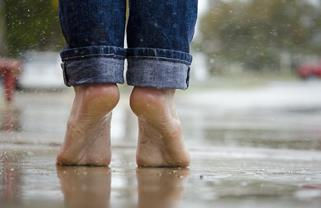Giving Birth with Aromatherapy (Part 2)
- Chin Ling
- Jul 25, 2014
- 3 min read
Updated: Dec 8, 2022
(This follows on from my post part 1 of Giving Birth with Aromatherapy; also refer to Aromatherapy during Pregnancy.)

HOW TO USE THE OILS
The essential oils, if used for massage, are blended into a carrier oil. Maximum is 2 drops of essential oil to 5ml of carrier oil. As your senses will be heightened during the labour, you can reduce this to 1 drop of essential oil per 5ml or carrier. You must be precise with the measurements. The blend can then be massaged into the skin, favourite places being the back or the abdomen. If you can, try the soles of the feet. Oils can penetrate into the bloodstream very effectively through the feet. Be careful of course if you are walking about.
Putting oils onto a face pad or tissue I have already described.
To make a compress add about 5 drops of essential oil to 500ml of warm water. Agitate the water to circulate the oil which will float around the surface, then dip in a face flannel, wring out and apply to the body. Someone will have to do this for you.
You could put the oils in a burner so that the vapours are inhaled and enter the bloodstream that way, but I would not personally recommend this because it could be awkward for the people working in the delivery room.
Do remember that whatever method you choose, you will (hopefully) not be the only person in the room and so whatever affects you may also affect the other people near you. And lastly, this applies more if you are massaging in oils, I always thought it would be nice if baby smelt you as you are 'au naturel', so don't overdo the scents.

POST-NATAL
If you have sustained tears or cuts from the labour, lavender is a wonderful oil to help the healing process. Maggie Tisserand in her book "Aromatherapy for Women" recommends a sitz bath, also known as a hip bath where you sit yourself in a few inches of water in a bath or a special bowl used for this purpose. You can use 3-5 drops of lavender blended in milk or oil and added to warm water or a blend of cypress (2 drops) and lavender (3 drops). Cypress oil (cupressus sempervirens) is astringent and stimulates the blood vessels in the area to close over while lavender heals and encourages growth of new skin as well as providing an antiseptic action. This could be ideal to do regularly if you have suffered perineal trauma.
Another method is to use a compress. Use 8 drops of lavender oil to 50ml of cold water. Agitate gently, then lay several layers of gauze into the water, wring out and lay over the wound held in place with a sanitary pad. Repeat after 10-20 minutes. Gauze is better than a flannel as the water and essential oils soak in better. Layers are required to give thickness.
In the Ipswich Hospital study, lavender together with tea trea (melaleuca alternifolia) is recommended for infected wounds. Tea tree is an extremely strong antiseptic, it penetrates infected wounds and clears away excess pus; it is anti-viral, anti-fungal and anti-inflammatory. Tea tree can be used directly on the skin directly on the infected area but I would still recommend it in a compress or sitz bath. The combination of lavender and tea tree is very powerful.
WHERE TO GET THE OILS
I made a list of carrier oils in my article Aromatherapy During Pregnancy. Here is a brief:
Grapeseed is an all-purpose oil, good for all skin types.
Almond is oilier, good for itchy skins.
Avocado, rich in vitamins A, B and D. Suits very dry skin and fatty areas. Better diluted.
Wheatgerm is very thick and must be diluted with a thinner oil such as grapeseed. 10% dilution. Rich in vitamin E, good for dry skin.
Peach kernel and apricot kernel are like almond oil but more expensive.
Evening primrose rich in GLA (gamma linoleic acids) so good for dry skins and premature ageing. Quite thick so should be diluted, 10% dilution.
Olive oil a bit similar to almond but strong odour.
Essential oils are used in such small quantities that I think it is worth getting the best quality. I have put the Latin names in brackets for all the oils talked about. When you buy, you should look for this name to ensure that you are getting the correct oil. Also, buy from a reputable supplier. Some good suppliers that sell to the public mail order are Eve Taylor, Tisserand, Bayhouse, Penny Price, Mother Earth, Purple Flame, Natural Touch.
SOURCES
Aromatherapy for Women - Maggie Tisserand
Aromatherapy Workbook - Shirley Price
Practice Group Midwifery, Gynacology & Neo-natal care on using aromatherapy - Ipswich Hospital 1992




Comments